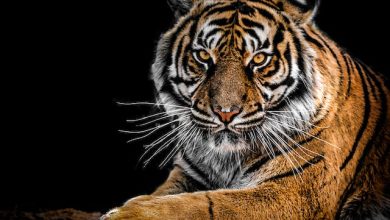African Masks: Intermediaries between the Living and Supernatural Worlds

African masks are viewed as intermediaries between the physical world and the supernatural realm of the dead, ancestors, and other spirits in many African communities.
Each African mask is produced in accordance with a particular traditional design, and a skilled performer dons it during a specific traditional rite.
African masking ceremonies are still considered to be a vital aspect of African culture and history and are still employed in significant rites and celebrations, even if they are not as widespread in Africa as they once were.
African masks and their ritualistic use are surrounded by elaborate and intricate beliefs.
Additionally, the wood used to make some African masks is so strong that only a select few—those who are wearing an African mask and culture elders—may touch it.
Almost everything related to the creation of African masks has a matching ceremony.
Because a certain tree’s wood is believed to have negative properties and may end up in anything manufactured from it, draining the power from the carved picture, one tribe would restrict its usage.
On the other hand, certain varieties of wood are highly valued since it is believed that they possess unique powers.
Also Read: Ancient Civilizations of Africa and African Empire
African sculptured masks
While creating an African mask sculpture, the artist is also preserving the cultural beliefs of his people. The incomplete component needs to be hidden while he is working on it or part of its power could be removed.
The dancer enters a profound trance during the mask ritual, and in this level of consciousness, he “communicates” with his ancestors.
The mask-wearer may occasionally be accompanied by a wise man or interpreter while performing the ceremony.
The dancer transmits advice from his forefathers via dancing. The translator will correctly interpret the meaning of the message even when it is grunted.
Songs, dances, and music performed on traditional African musical instruments are always a part of rituals and festivities.
Before the Paleolithic age, it is thought that the earliest masks were worn in Africa.
They symbolically stand in for the spirits of animals or ancestors, legendary heroes, moral principles, or a manner of paying respect to someone.
They are constructed of copper, bronze, fabrics, wood, pottery, and pottery.
Vegetable oil is typically used to the African mask once it is finished.
Also Read: African Beads: Waist Beads & Necklace Meaning
African Masks Meanings
Masks are a fundamental component of traditional African culture and have long played a significant part in ritual and ceremonial.
Both a concept and a shape, they are. African masks are clearly works of art, and for those who make them, they represent much more than just aesthetic appeal.
In general, the mask shape is a physical mechanism that triggers metamorphosis, allowing the wearer to assume a new identity and exert influence over the spirits he is thanking or praising.
Also Read: The Art of Body Painting: Traditional African Face Painting & Body Painting
The Art of Body Painting: Traditional African Face Painting & Body Painting
The Cultural Heritage that African Masks Protect
While there are many cultural variations in the precise meanings attached to ceremonial masks, most African civilizations share basic characteristics.
For instance, masks are frequently employed in ceremonial dances, social gatherings, and religious occasions. They typically have a spiritual or religious significance.
Both the artisans who make masks and the people who wear them during festivities are given a unique position.
The technique of manufacturing masks is typically passed down from father to son along with knowledge of the symbolic meanings that these masks communicate.
Different Shapes and Colors of African Masks
In the past, artisans created masks in a variety of shapes and styles using materials that were easily accessible.
Some of the materials used to build them include wood, ivory, metals, and animal leather. African masks are available in a wide range of hues, including red, black, orange, and brown.
Also Read: African Hairstyles’ Social Importance and Spiritual Significance
African Hairstyles’ Social Importance and Spiritual Significance
Animal Species
Masks are frequently created to represent people, animals, and other symbols of identity. Animals are a common motif in African masks.
Some African cultures hold the notion that wearing animal masks helps facilitate communication with the ghosts that dwell in open savannah or in woods.
Some masks, like The Morongociek, cover the complete body.
While most masks just cover the face, some, like this seclusion mask used by the Maa community, cover the entire body.
The Tiriki isolation mask
This is the best example of a full-body mask in action. The Tiriki youngster is shown with a mask on after being circumcised.
For a period of six months, initiates are the only ones who wear this mask while they prepare for maturity in isolation.
Keeping the Human form Hidden
When a mask is worn during a ceremony, the person theoretically loses their human form and becomes a spiritual being.
For instance, to make the act of penitence more altruistic, penitents may wear masks during rituals to conceal their identities.
This is a metamorphosis of the mask-wearer into a spirit, which typically depends on other activities, such as certain genres of music and dance, or ceremonial attire that helps to disguise the mask-human wearer’s identity.
A Kuria guy wearing a mask to hide his identity is portrayed.
Also Read: African Tribes, Culture, & Traditions: Top Five Tribes of Africa with Traditional Cultures
African Tribes, Culture, & Traditions: Top Five Tribes of Africa with Traditional Cultures
Masks provide entertainment value
Because they were employed to amuse the crowd, masks were crucial during festivities. The masks gave the dancers a more dynamic appearance, which greatly increased the audience’s attention.
Settings for Mask Rituals
The person wearing the mask may develop into a kind of medium who facilitates communication between the living and the dead.
The spirits described are frequently either tied to nature or the deceased. The majority of traditional African ceremonies for marriage, burial, initiation rites, and purification include mask dancing.
Preserving the Wearer’s Dignity
Most Kenyan groups did not support open sexuality, and those who participated in fertility rites typically wore disguises to avoid social shame.
Without masks, the participants who performed the rituals were unable to do so, demonstrating that masks provided them the confidence to continue.
Also Read: 7 Incredible African Tribal Custom
Punishment
Sometimes masks are used as a form of corporal punishment, either to indicate the wearer’s shame or to actually harm them.
Some societies used hideous masks. A “shameful” mask is created for public humiliation; other masks, particularly unpleasant ones, such an iron mask, were used to punish social outcasts.
Symbols of Power
In the past, masks were used to convey an unquestionable authority to the wearer. This implies that powerful individuals in society once wore masks as a sign of their status and authority.
People used to create masks that resembled deceased rulers, including chiefs or kings, as a way to pay tribute to them.
These masks served as both a reminder of the ruler’s existence and a way for people to remember him in the future.





